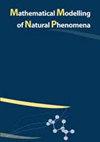Heat and mass diffusion to Williamson fluid streaming through a tube with multiple stenoses while subjected to periodic body acceleration
IF 2.1
4区 数学
Q2 MATHEMATICAL & COMPUTATIONAL BIOLOGY
引用次数: 0
Abstract
This article examines a mathematical framework that describes the versatile behavior of heat and mass exchange in blood flowing through a narrowed vessel having multiple stenoses. The geometry of a channel having multiple stenoses with an asymmetrical axial axis and a symmetrical radial axis can be visualized by applying a suitable mathematical expression. The geometry of the chosen model considers the height and shape of stenoses. The modification in shape parameter is used to capture variations in the shape of the stenoses in the artery. The blood is supposed to be isochoric (incompressible), while its rheological behavior is characterized by Williamson’s fluid model. The transfer of momentum is analyzed using the equation of motion in cooperation with the continuity equation. In addition, the equations of heat conduction and diffusion are utilized, respectively, to illustrate the distributions of heat and mass. Simplified forms of momentum, mass, and heat transport equations are achieved by incorporating dimensionless quantities and moderate stenosis conditions. A well-known explicit finite difference approach is utilized to solve the emergent non-linear system of governing equations numerically. The influence of different evolving parameters on the flow field along with mass and heat distributions is illustrated through various plots.热量和质量扩散到威廉森流体流过多管狭窄,同时受到周期性的身体加速度
本文研究了一个数学框架,该框架描述了在具有多个狭窄的狭窄血管中流动的血液中热交换和质量交换的多种行为。具有具有不对称轴向轴线和对称径向轴线的多个狭窄的通道的几何形状可以通过应用合适的数学表达式来可视化。所选模型的几何形状考虑了狭窄的高度和形状。形状参数的修改用于捕捉动脉中狭窄形状的变化。血液被认为是等容的(不可压缩的),而其流变行为由威廉姆森流体模型表征。动量的传递是使用运动方程和连续性方程来分析的。此外,还分别利用热传导方程和扩散方程来说明热量和质量的分布。通过引入无量纲量和中等狭窄条件,实现了动量、质量和热传输方程的简化形式。利用一种著名的显式有限差分方法对涌现的非线性控制方程组进行了数值求解。通过各种曲线图说明了不同演化参数对流场以及质量和热量分布的影响。
本文章由计算机程序翻译,如有差异,请以英文原文为准。
求助全文
约1分钟内获得全文
求助全文
来源期刊

Mathematical Modelling of Natural Phenomena
MATHEMATICAL & COMPUTATIONAL BIOLOGY-MATHEMATICS, INTERDISCIPLINARY APPLICATIONS
CiteScore
5.20
自引率
0.00%
发文量
46
审稿时长
6-12 weeks
期刊介绍:
The Mathematical Modelling of Natural Phenomena (MMNP) is an international research journal, which publishes top-level original and review papers, short communications and proceedings on mathematical modelling in biology, medicine, chemistry, physics, and other areas. The scope of the journal is devoted to mathematical modelling with sufficiently advanced model, and the works studying mainly the existence and stability of stationary points of ODE systems are not considered. The scope of the journal also includes applied mathematics and mathematical analysis in the context of its applications to the real world problems. The journal is essentially functioning on the basis of topical issues representing active areas of research. Each topical issue has its own editorial board. The authors are invited to submit papers to the announced issues or to suggest new issues.
Journal publishes research articles and reviews within the whole field of mathematical modelling, and it will continue to provide information on the latest trends and developments in this ever-expanding subject.
 求助内容:
求助内容: 应助结果提醒方式:
应助结果提醒方式:


